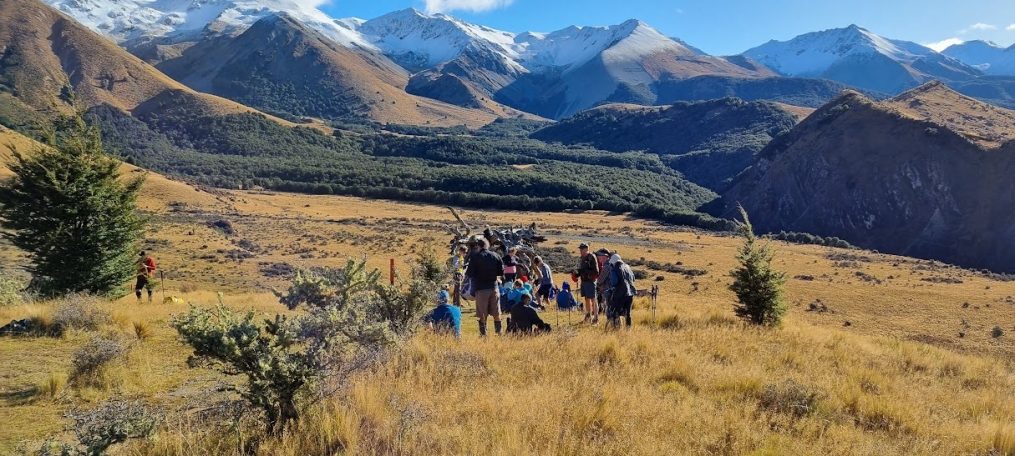| Group | Leader | Mentor | Tailender |
| Standards | Lynne R | Jan Br | Graham W |
| Alternates | Ali | Maureen C | Kiwan |
Distance 15km, ascent 672m, time 4hrs 45mins
While we were travelling by bus all the way to Mt Alexander there could easily have been a procession of psychedelic unicorns pulling chariots laden with burlesque dancers going past, but the fog was so thick they would have gone by unnoticed. All credit goes to driver Garth for driving us skilfully through all the murk and mist.
However, it was a pleasant trip, with the joy of being on the receiving end of three rounds of little treats and the fun at watching Bev trying to stuff large bags of used bras and swimming togs into the overhead racks (don’t ask).
We arrived safely at our destination and caught a glimpse of Andy Fox, the fourth-generation owner of the property, Foxdown Farm. He kindly allows us to walk on his 14,000ha sheep and cattle farm for a smallish koha, which we’re told he will be donating to the local fire brigade this year.
So, 34 trampers including guest Peter S set off uphill towards the nicely maintained pine plantation which was still shrouded in mist. Then, voila! Sunshine! Before long the 21 Standards, soon followed by the 13 Alternates, made it to one of the most unusual morning tea spots our club gets to enjoy. This is a very old sheep yard, studded with trees and still bordered on one side by an authentic drystone wall. There can’t be many like this in the whole of New Zealand and this one is in excellent condition. It was just lovely sitting in the sunshine, being serenaded by magpies.
Soon after smoko we encountered two very startled-looking newlyweds driving carefully down the track from the very flash Foxdown Hut.
The Standards made it to the last steep climb, negotiated the difficult barbed wire fence and chose lunch spots near the trig at the top of Mt Alexander. The Alternates, who arrived soon after, favoured possies closer to the massive radio masts. In fact, the view from anywhere at the top was superb – all the way down to the Waikari basin, across to Lake Sumner, the snow-capped Southern Alps in the distance, and the Kaikoura range far away to the north. Eating our lunch with no wind to contend with and with sunshine on our faces was just blissful. Even a discussion on the sad state of US politics couldn’t cast a shadow of gloom on the participants.
The Alternates set off again the same way they had come up (but obviously all downhill this time!) while we Standards took a longer, more undulating route. The pine plantation we had encountered at the start of our giant loop tramp looked a long way away, because it was, but at least the bigger ‘undulations’ weren’t as muddy as they could have been. This was a sign of the severe recent drought, as was the fact there was hardly any stock left on the farm this winter (though there was still a lot of sheep and cattle poo to stick to our boots).
The Standards made it back to the bus first, followed soon after by the Alternates. There was just enough time for a quick look around Foxdown’s splendid collection of classic cars, which appears to be still expanding.
By the end of our pleasant, uneventful tramp any vestiges of cabin fever from not having tramped for a couple of weeks had dissipated just like that morning fog, and it was a bunch of happy trampers who boarded the bus for the trip back from Foxdown to Fogtown.
Text by Shirls











































































